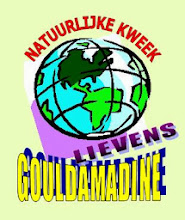 Photo by Arlene Martin, California
Photo by Arlene Martin, California" Real " ???
blue-breast ? or merely temporary
"accident" ?
°°°°°°°°°°
Melanin is made up out of tyrosine, which is an amino acid. When an overmelanisation of the bird's feathers is established, with black spots or entire fields of black pigmentation (and/or enlarged optically blue areas) in the neck or back zone feathering, this is mostly due to a dysfunction in the tyrosinase phase with the enzym in question having been too active, urging the metabolism to overproduce black melanin. Although this extra produced eumelanin is mostly seen to settle down in the back and neck zone, some fractions of it can equally find their way through towards the breast zone.
Overmelanisation can be triggered by a number of environmental factors at the level of housing and feeding, but statistically speaking, lying at the very basis of this phenomenon are 2 main factors :
Although one year old normal coloured gouldians can also in a later stage of their life become melanotic in appearance –as a result of metabolic imbalance due to fi sickness episodes or straight onesidedness in feeding approaches during moulting- , it has to be said that most melanotic birds are of an age younger than 1 year. In most cases these melanotic birds often show a less stable health condition. When introduced into larger aviary populations of gouldians, these melanotic birds are more frequently and more rapidly the victims of picking by other gouldians (mostly as the population steadily gets more hormonally active.)
Tyrosine also being a precursor to hormones, in most cases melanotic blue-breasts will regularly display deviating hormonal activity and irregularities in breeding behaviour. If they are at all up to any breeding activity to begin with. When not kept separated from other gouldians and given special attention and pampering, these birds again are also more likely to develop stress related health problems as a spin off result of these hormonal deviations.
Up until this day we ourselves nowhere in the world -whatever the kind of gouldian breeding facility we witnessed, be it fostered or naturally inspired- have we never-ever encountered a genetically determined and stable blue-breast appearance deserving to be called "mutation". Nor have we ever seen any sort whatsoever of blue breast gouldian capable of effectively producing regular blue breast offspring.
This much being said it is equally to be added that no doubt the day will come that genetically stable blue-breast gouldians will emerge, carrying in themselves a genetically mutated condition enabling them to filter out brown phaeomelanin pigment at the level of the breast zone and/or replacing it by, or reforming into black pigmentation due to higher levels of pigment oxidation capabilities. Optically providing a blue breast zone, with the gouldian at the same time being able to pass it on to the next generation. Today however, dreamers of genetically stable bluebreasts have to sit and wait.
Overmelanisation can be triggered by a number of environmental factors at the level of housing and feeding, but statistically speaking, lying at the very basis of this phenomenon are 2 main factors :
1. an insufficient balance in assimilating required nutritional elements from an early age on, whatever the direct cause, especially at the level of protein assimilation.
2. Also a specific disbalance in several b-vitamins (especially B12) and/or some other crucial bio-active elements during youth moulting, can even more advance and promote a dysfunction in the tyrosinase phase, resulting in an overproduction of eumelanin (black pigment).
Although one year old normal coloured gouldians can also in a later stage of their life become melanotic in appearance –as a result of metabolic imbalance due to fi sickness episodes or straight onesidedness in feeding approaches during moulting- , it has to be said that most melanotic birds are of an age younger than 1 year. In most cases these melanotic birds often show a less stable health condition. When introduced into larger aviary populations of gouldians, these melanotic birds are more frequently and more rapidly the victims of picking by other gouldians (mostly as the population steadily gets more hormonally active.)
Tyrosine also being a precursor to hormones, in most cases melanotic blue-breasts will regularly display deviating hormonal activity and irregularities in breeding behaviour. If they are at all up to any breeding activity to begin with. When not kept separated from other gouldians and given special attention and pampering, these birds again are also more likely to develop stress related health problems as a spin off result of these hormonal deviations.
Up until this day we ourselves nowhere in the world -whatever the kind of gouldian breeding facility we witnessed, be it fostered or naturally inspired- have we never-ever encountered a genetically determined and stable blue-breast appearance deserving to be called "mutation". Nor have we ever seen any sort whatsoever of blue breast gouldian capable of effectively producing regular blue breast offspring.
This much being said it is equally to be added that no doubt the day will come that genetically stable blue-breast gouldians will emerge, carrying in themselves a genetically mutated condition enabling them to filter out brown phaeomelanin pigment at the level of the breast zone and/or replacing it by, or reforming into black pigmentation due to higher levels of pigment oxidation capabilities. Optically providing a blue breast zone, with the gouldian at the same time being able to pass it on to the next generation. Today however, dreamers of genetically stable bluebreasts have to sit and wait.
More items for English readers :
Claim Analysis : Fosterer's statement of the century
Feedback in English on other technical issues : tel.0032(0)53 838224
Tekstbewerking : Lester-Lawrence Lievens -
Tekst : Ivan Lievens
_________________________________________________________

























































